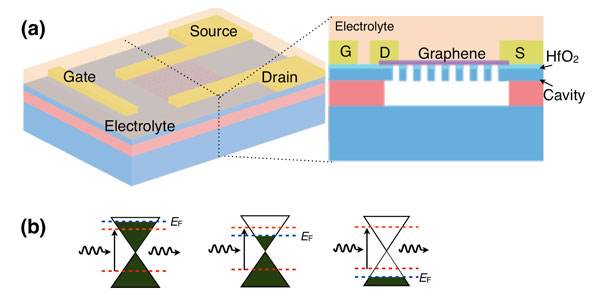Researchers have succeeded in making a new electro-optic modulator from graphene by coupling the carbon material to a photonic crystal nanocavity. The device achieves high modulation of over 10 dB and could usher in a new generation of compact, low-power modulators.

Graphene Nanocavity
Graphene – a 2D sheet of carbon just one atom thick – has many unique physical and mechanical properties that make it ideal for optoelectronics applications. One advantage is that charge carriers (electrons and holes) move much faster through graphene than through other materials.
The material is also very good at absorbing light over a very wide range of wavelengths, from the visible to the infrared (a part of the electromagnetic spectrum that is important for optical telecommunications). This is unlike III-V semiconductors that do not work over such a wide range. It also reacts to light extremely quickly, which means that it might be used to create devices that are much faster than any employed in optical telecommunications today.
A team led by Dirk Englund at Columbia University made its electro-optics modulator (an important device in computing and communications) by coupling a silicon photonic crystal nanocavity to a graphene monolayer. As shown in the group previous work, the graphene-nanocavity system can absorb more than 45% of light falling on it.
In the new experiments, the researchers electrically gated the graphene using a top polymer electrolyte, which creates a high electrical field and a large number of carriers in the carbon material. This approach ups the Fermi level of graphene by as much as 0.85 eV, something that causes “Pauli blocking” of interband transitions in the material and greatly increases the amount of light reflected by the coupled nanocavity. Pauli blocking occurs if the orbitals of electrons or holes are occupied, preventing these carriers from exciting further and thus allowing photons to be transmitted.
Wide bandwidth operation at low power
“Our research shows that high-contrast graphene optoelectronic modulators can be constructed on photonic integrated circuits and that they can operate on very little power.” Englund told nanotechweb.org. “Graphene absorbs light quite strongly, so high contrast can be achieved in these devices even with relatively low cavity quality factors. As a result, they can operate over a wide bandwidth near 300 GHz, which makes them less susceptible to thermal fluctuations in photonic circuits.” Thermal fluctuations are the bane of more conventional, high-Q electro-refractive modulators, such as silicon rings, that work by free carrier effects.
Thanks to the high carrier mobility of graphene and the fact that the device can be made very small, it also looks as though the modulator could operate at very high speeds, reaching 100 GHz or more, he adds.
The team says that it is now busy working on new devices in which the graphene is controlled through electrical contacts integrated into the silicon resonator itself. “We anticipate that such modulators could reach speeds in excess of 10 GHz, and possibly much faster,” said team member Xuetao Gan.
The current work is reported in Nano Letters.

